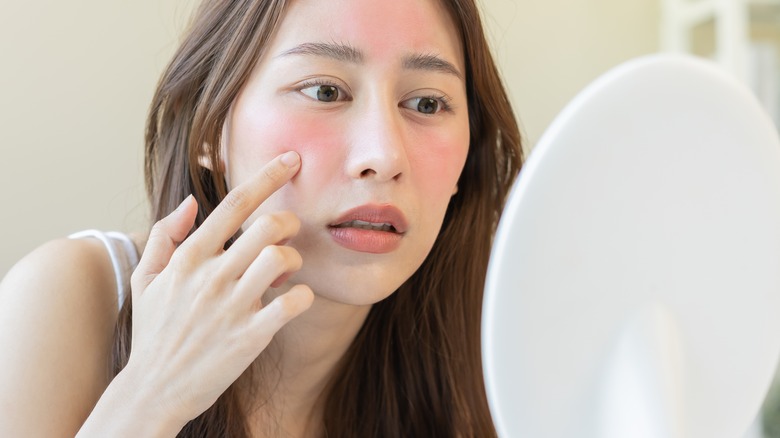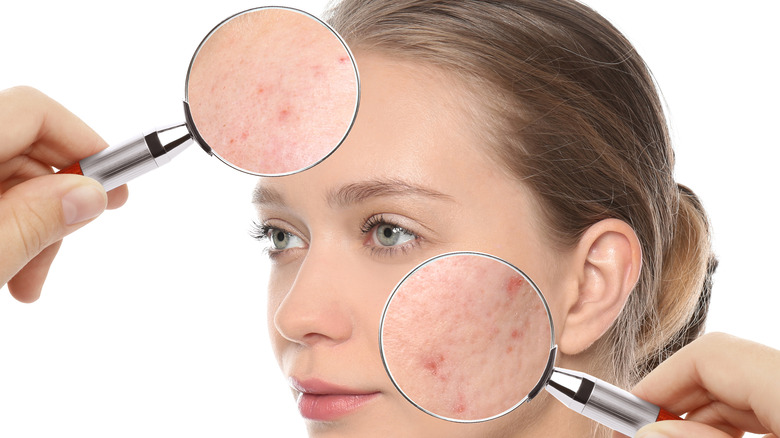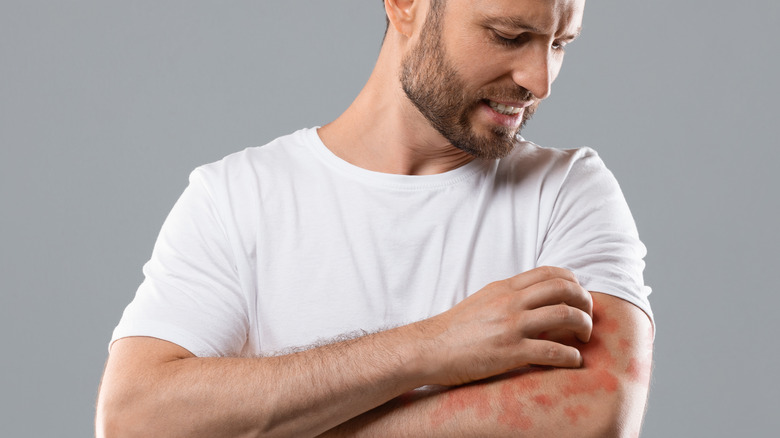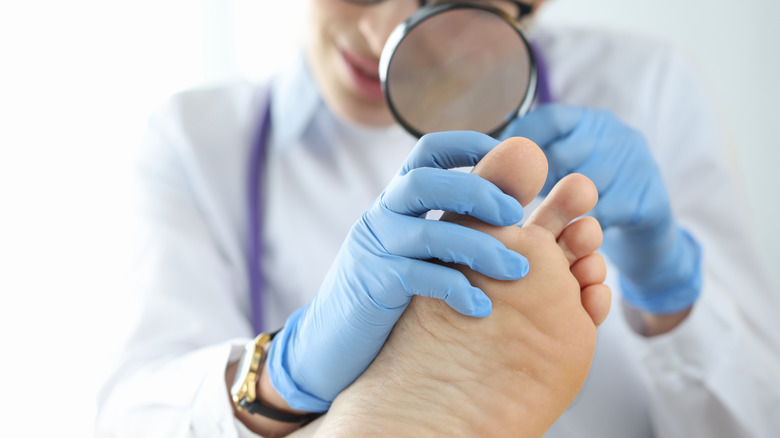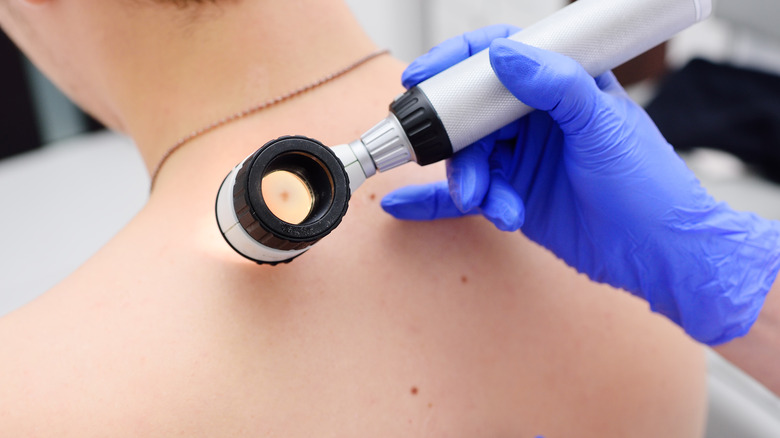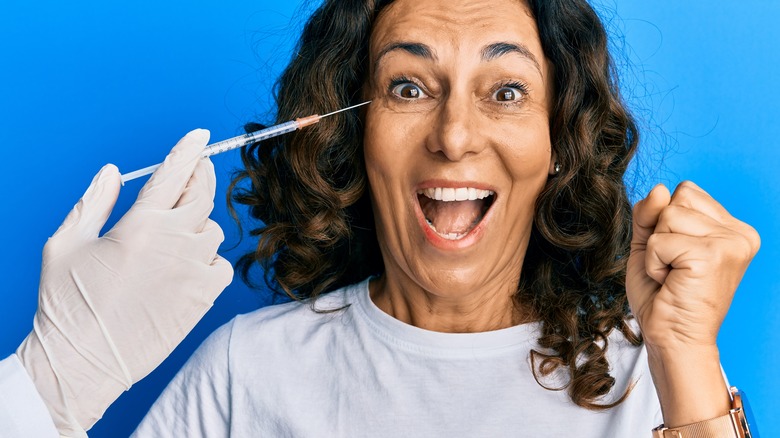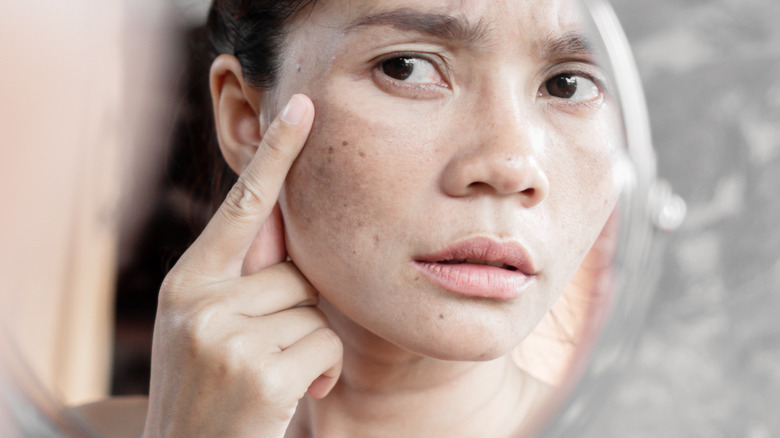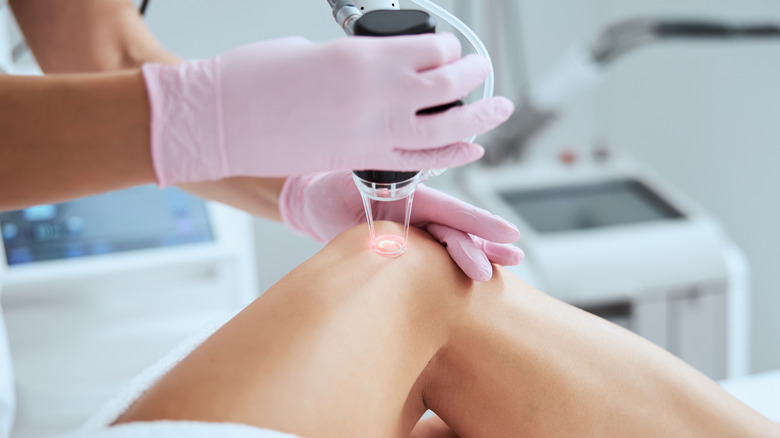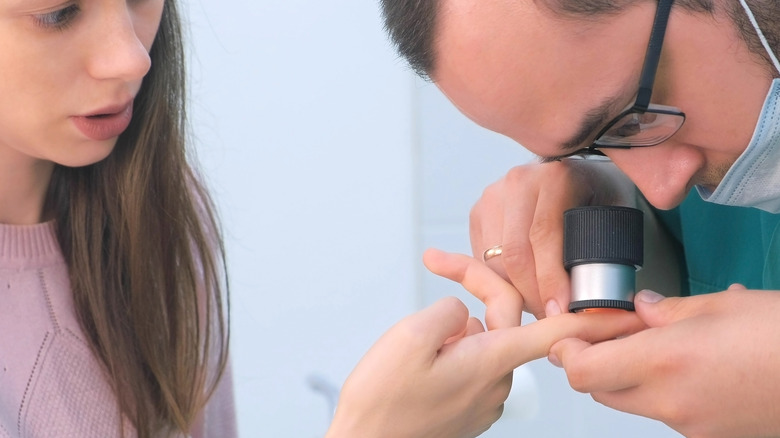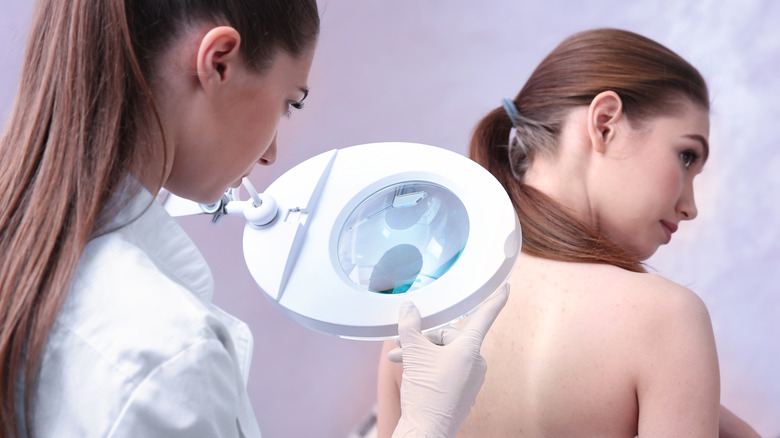Make An Appointment With Your Dermatologist If You Notice One Of These Skin Conditions
A rash on your body? Hair loss? Weird moles? Those are all great reasons to call on a board-certified dermatologist. As medical doctors, they evaluate and treat over 3,000 conditions and are the experts in skin, hair, and nails, says the American Academy of Dermatology.
But why go to a dermatologist when you can just see your family doctor? Depending on your particular concern, sometimes both types of doctors are a great choice — but not always. "Many primary care doctors have little training with dermatologic conditions," says Dr. Jules Lipoff, an assistant professor of clinical dermatology at the University of Pennsylvania and co-author of a 2020 study that shows non-dermatologists were only able to correctly diagnose dermatology cases about 20% to 50% of the time (via Reuters).
Especially for the more complex skin issues and anything with a systemic component, a dermatologist has the special training and expertise to make quicker and more accurate diagnoses, confirms the Cleveland Clinic. So let's take a look at some common conditions that warrant a trip to a dermatologist's office.
Onset of hives or rash
The sudden eruption of a big rash or itchy, welty hives across your body is certainly unsettling. Either one can be triggered by almost anything — an allergic reaction from an insect bite, a viral or bacterial infection, a medication you've just started taking, or simply from being overheated. Rashes and hives can even be caused by stress, With some types of rashes, you may also get other concerning symptoms too, such as body aches, blisters, sore throat, or fever, says Medical News Today.
Not every rash is a cause for concern, and you probably wouldn't rush to a doctor for a small patch of contact dermatitis. But if you're experiencing a rapidly spreading rash that covers more than 10% of your body — and if it's accompanied by other symptoms — WebMD advises you should get in to see a dermatologist or other healthcare provider right away for evaluation and treatment. For minor things, you'll find plenty of over-the-counter medicines to make you feel more comfortable until the problem subsides, but a dermatologist will be able to accurately diagnose the problem quickly and prescribe the most effective treatment.
Persistent facial redness
Although many people think that rosacea just means you blush easily, it's actually a lot more complicated than that. It's a chronic skin condition in which enlarged blood vessels bring more blood flow to the center of the face — usually the cheeks and nose — giving those areas a persistently sunburned appearance. In addition to the ruddy complexion, rosacea may also be itchy, bumpy, and painful, says WebMD. The disorder usually affects people in middle age, but what triggers the issue is not entirely known. Genetics, an overactive immune system, and sometimes an overabundance of Demodex mites on the face may play a role, according to Well+Good. But one thing everyone can agree on is that rosacea is a condition that's best handled under a specialist's care.
Since it's a complex problem, you can do more harm than good if you try to cover up rosacea or self-treat it with drugstore products. "Makeup may camouflage the early signs of the disorder, [but] it will have no effect on the underlying disease process — and over-the-counter acne remedies can make it worse," reveals the National Rosacea Society. Your dermatologist may prescribe special creams or gels to constrict the affected blood vessels, or recommend diet changes, laser treatments, or oral medications. Finding the right approach may take some time, but it'll be worth it.
Stubborn acne
If you have stubborn pimples that are causing you grief, dermatologists have a wide range of options available for treating the condition. Nodules and cysts are the worst types of acne, causing lots of inflammation on the skin that can leave deep pits on the face if you don't seek out specialized treatment. So being under a dermatologist's care early on gives you the best chance of getting problematic acne under control and minimizing scarring, according to WebMD.
For mild acne or occasional flareups, you can find effective over-the-counter topicals that dry out pimples with benzoyl peroxide or salicylic acid, confirms GoodRX. And if you combine those medications with periodic visits to an esthetician, gentle acne facials with extractions of blackheads and whiteheads can go a long way toward improving your skin (via Medical News Today). But those OTC remedies aren't adequate for the more severe forms of acne. A dermatologist will have stronger and better-targeted treatments within reach, such as prescription-strength retinoid creams or antibiotics that can reduce bacteria and inflammation on your skin, says the Mayo Clinic.
Itchy raised patches on your body
Psoriasis affects over seven million adults in the U.S., according to Healthline. If you see the raised, angry-looking patches with silvery scales appearing on your knees, elbows, trunk, or scalp, you might think it's some sort of weird rash. But psoriasis is a chronic skin disease that has no cure, says the Mayo Clinic. You have a higher risk of getting it if psoriasis runs in your family, but it can strike anyone. Stress or a strep infection — or even certain medications — can be the triggering event that causes a change in your immune system and brings on the symptoms (via the National Psoriasis Foundation).
Dermatologists are specially trained in the evaluation and care of this life-long and complex condition, so seeking one out early is a critical component in keeping psoriasis under control. Your dermatologist can help relieve the disease's multiple symptoms, such as intense itching, and create an individualized treatment plan that will lead to clearer skin for longer periods as well as monitor for signs of it worsening, per Medical News Today.
Nails that don't look normal
Your nails are a window into your general health. When nails are in good condition, they're strong and healthy. So if you've noticed that your nails are looking kind of funky, it's time to get the problem checked out by a professional. Pitted, dented or brittle nails, icky fungus, nail thickening or lifting, or a black streak under the nail bed are all signs that something's off. A dermatologist is the right choice to diagnose and treat these kinds of problems.
At your appointment, your dermatologist will visually examine your nails and may need to do tests to confirm a diagnosis. Depending on what the issue is, the American Academy of Dermatology says specialists have an array of options available to treat it, including topical or oral medications, corticosteroid injections, or even laser therapy. Occasionally a problem might make it necessary to remove part of your nail, such as severe fungus or if the majority of the nail is diseased, says WebMD. Issues like nail pitting may signal underlying infections like psoriasis or other autoimmune disorders, or possibly contact dermatitis, according to Healthline. Dark streaks in the nail bed though might be a sign of melanoma — the most serious kind of skin cancer — so don't delay seeking a diagnosis.
Sores that won't heal
It can take up to four weeks for a wound to heal, but if it doesn't seem to be getting any better then poor circulation, excessive swelling, or inadequate nutrition may be the cause, warns Summa Health. Problematic wounds look like a round open sore on the skin with a raised and thick outer border. The area might also look red or blue, depending on your skin color, and feel warm to the touch. "As the skin ulcer worsens, it will begin to look like a crater [and] will typically begin to weep clear fluid or even blood," warns the Infectious Disease Associates of Tampa Bay. Those who are cigarette smokers, pregnant, obese, elderly, or have high blood pressure, are at higher risk of this type of complication.
Since you don't want the wound to become infected, it's crucial to get it looked at by a doctor. What might initially seem like not such a big deal can quickly ramp up into an urgent medical problem that has the potential to spread the infection to deeper tissues or get into your bloodstream, per Orlando Health.
Hair falling out
About 70% of men lose hair as they get older, and a quarter of them will start seeing thinning hair by the age of 21. For women, the statistics show 50% will experience some hair loss in their lifetime. Consulting with a dermatologist early is key to minimizing the issue, which is known as alopecia. "There are a lot of lookalike diagnoses that can be mistaken for other things, and treatments can be complicated with combination therapies that often need to be monitored," explains Dr. Amy McMichael, professor and chair of the Department of Dermatology at Atrium Health Wake Forest Baptist Medical Center in North Carolina (via U.S. News & World Report).
There are two types of hair loss, one is called scarring, a rare but permanent condition that destroys the hair follicle. The other is referred to as non-scarring, and it means the hair follicle was retained and has the potential for regrowth. By seeing a dermatologist, you'll be in a better position to manage hair loss or reverse it, according to NYU Langone Health. But why does alopecia happen in the first place? The most common reasons are heredity, hormonal changes, medications, inadequate nutrition, radiation, or certain medical conditions like thyroid disorders, anemia, and polycystic ovary syndrome. Treatments have evolved over the years and can be very effective, including hair transplant surgery, lasers to stimulate circulation and growth, injections of platelet-rich plasma (PRP), and oral and topical medications.
Mole changing shape or size
Most of us have a mole or two, and some of us have a ton of them. Normal moles are evenly colored, flat or raised, round or oval, and about the width of a pencil eraser. But why do we get them? They form when cells clump together rather than evenly spread across the skin. It's important to keep tabs on them because one of the first signs of skin cancer is a change to a mole's shape or color, warns the American Cancer Society. The good news is that most moles are completely harmless.
The surest way to find out if any of your moles are a red flag is to see your dermatologist for a skin check-up. Your doctor will take a look at them and either give you the all-clear or remove some for biopsy if any look suspicious, explains the Mayo Clinic. If you just don't like the looks of a particular mole because you think it's ugly, your dermatologist will be happy to remove it for you — but you may be trading a mole for a scar.
You're looking older than your age
Under the skilled hands of a dermatologist, looking younger these days is easier than ever before. Got frown lines? Dull skin? Uneven skin tone? Thinning lips? Loss of volume in your cheeks? All can be solved — at least temporarily — with an injection of derma fillers or Botox, or by using exfoliating chemical peels, lasers, or prescription topical medications, says WebMD. Anti-aging treatments, administered by cosmetic dermatologists or other specialists, have become a booming business. And though prices for a lot of the procedures are sky high and out of reach for many, there are some options that are comparably affordable.
"While one procedure may give you the lifting you need, another will tighten your skin, and another is going to give you skin tone and texture improvement," says New York dermatologist Dr. Doris Day. "The goal is never to chase the lines, but to identify and treat the source," she told NewBeauty.
Dark patches on the skin
When you have uneven skin tone caused by hyperpigmentation — the overproduction of melanin — there are two likely culprits. The first is the hormonally-driven melasma, which causes dark patches on the face. The second is lentigo (aka "liver spots"), which appear on the hands, chest, and face, or after an inflammatory condition like acne or eczema. With both skin conditions, sun exposure is a major contributing factor, per Healthline.
Clearing or improving these darkened areas of skin is possible with consistent treatment by a dermatologist. Topical ointments and creams, cosmetic procedures like lasers, intense pulsed light (IPL), microneedling, and a variety of chemical peels are all commonly used, according to Medical News Today. Often, combinations of different treatments will be applied over a long period of time to get results.
Dr. Pearl E Grimes, director of the Vitiligo and Pigmentation Institute of Southern California, told Dermatology Times that treating hyperpigmentation "is not a one-trick pony — it requires a stable, all moving synchronously, dancing and bobbing to achieve a win." With every approach, the consistent use of high-SPF sunscreen is important so you're not taking two steps forward and one step back. Unprotected sun exposure can easily undo all the progress that you've made.
Unsightly veins on face and body
Sun, hormones, genetics, or just the passage of time, are the reasons some of us end up with spider veins on the legs or broken capillaries (telangiectasias) on the nose and cheeks. They're blue, purple, or red flat thin lines — the result of weakened, dilated veins — which branch out in twisted or weblike patterns under the skin. They're not harmful but once you've got them, spider veins and broken capillaries are not going to go away on their own, according to Medical News Today.
Treating this annoying problem is luckily pretty easy under a dermatologist's care, though the procedure can set you back some bucks. "A lot of people are bothered by the appearance of these blood vessels, and they don't know they can be treated," says Dr. Joshua Tournas, a dermatologist at Banner Health in Arizona. For spider veins on the legs, says the Cleveland Clinic, a saline solution from sclerotherapy or heat from lasers will collapse unsightly tiny varicose veins and leave you with clearer skin. For broken capillaries, different types of lasers and light therapies, and electrocauterization, are first-line treatments.
Painful or itchy warts
Shaking hands and turning doorknobs are some common ways you can catch warts. These skin-colored hard bumps, which are dome-shaped or flat and feel rough to the touch, are caused by a common virus. So if you have dry, cracked skin or a tiny cut or scratch on your fingers, that's the welcome mat for the human papillomavirus to come marching in. "HPV is ubiquitous," says dermatologist Dr. Conway Huang, an associate professor of dermatologic surgery and cutaneous laser surgery at the University of Alabama at Birmingham (via WebMD). "We all come in contact with it."
Your dermatologist will be able to diagnose and treat the wart and get it to fall off by freezing it with liquid nitrogen or by using topical medicines or laser therapy, says the Cleveland Clinic. There are plenty of over-the-counter patches and ointments too, but warts have deep roots, says The Dermatology Center of Indiana. So, nonprescription solutions may not reach deep enough to destroy all of the wart.
Scars you want to look better
Scars fade over time, but if you want to remove or further minimize them, it's not always easy. There are so many different types of scars — raised hypertrophic, thick keloids, and contractures — and each type will require a different approach. Your age, skin color, scar location, and how long you've had it, are other important factors when deciding on a treatment. So seeking out a specialist with the skill and experience to improve the look of your scar is going to make a difference in the final result, says the American Academy of Dermatology.
Examining your scar is the first step so your dermatologist can recommend an effective treatment. Lots of good options exist, such as pressure therapy, retinoids, silicone sheets, lasers and other light treatments, microneedling, fillers, corticosteroid injections, cryosurgery, and scar revision through surgical excision.
Melanin-rich skin is another consideration when deciding on options, as it's more likely to be irritated and inflamed by peels and lasers, or become darker in the areas treated. "Not every procedure we do in lighter skin is good for darker skin," warns Dr. Jasmine Onyeka Obioha, a Cedars-Sinai dermatologist. "So patients have to be really intentional in seeing someone who is experienced with a diverse patient group."
It's been a year since your annual skin check-up
Dermatologists are trained in detecting skin cancer, the most common form of cancer in the U.S., per the Cleveland Clinic. If you have a family history of skin cancer or have spent a lot of time baking in the sun, or using tanning beds, annual skin checks are especially recommended. "Being at increased risk doesn't mean you'll get skin cancer, but you may need to start regular screenings in case you do get skin cancer and it can be caught early," says dermatologist Dr. Benjamin Kelley of Scripps MD Anderson Cancer Center in California.
During an exam, your dermatologist will examine your skin from head to toe, looking for anything that appears suspicious for cancer. They'll often use a bright light or a magnification instrument called a dermatoscope, says Cancer Research U.K.. Anything that grabs your doctor's attention as possibly being cancerous or precancerous will get photographed and likely numbed and nipped out for a trip to a lab for biopsy.


